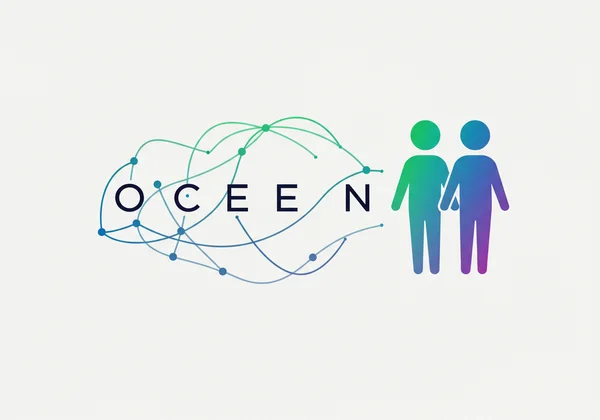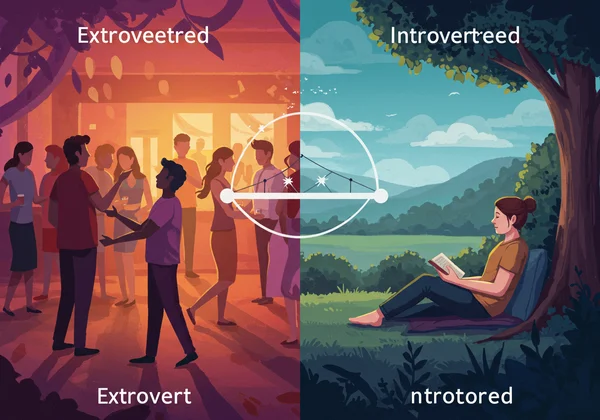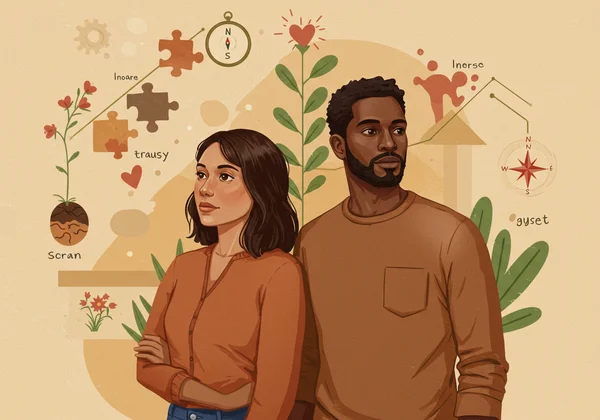Big 5 Personality Test in Love: Personality Traits, Compatibility & Relationships
Relationships can be a fascinating puzzle. Why do some connections feel effortless, while others present a constant challenge? Often, the answer lies in understanding personality – specifically, the scientifically-backed Big 5 model. Exploring your Big 5 personality test results, and those of your partner, can unlock profound insights into your romantic dynamics. This guide will reveal how each of the five core traits influences attraction, communication, and long-term compatibility, empowering you to build stronger, more empathetic partnerships. Ready to uncover your relationship map? Discover your traits today.
The Big 5 Model: Your Map to Relationship Dynamics
The Big 5 model is a cornerstone of modern psychology, providing a reliable framework for understanding human personality. Unlike categorical labels, it measures five broad dimensions on a spectrum: Openness, Conscientiousness, Extraversion, Agreeableness, and Neuroticism. In relationships, these traits are not about finding a "perfect" match, but about understanding the landscape of your and your partner's inner worlds.

How Personality Shapes Connection and Communication
Your personality traits are the invisible forces guiding how you connect. They influence your communication style, what you need to feel secure, and how you express love. Understanding these core drivers helps you move from confusion ("Why do they always do that?") to compassion ("I understand this is part of their personality").
Understanding the OCEAN Traits for Deeper Love
Often remembered by the acronym OCEAN, these five traits offer a map to deeper intimacy. Knowing where you and your partner fall on each spectrum allows you to appreciate your similarities and navigate your differences with empathy. This understanding is the first step toward building a love that is both passionate and resilient. Ready to map your personality? Take the test now.
Openness to Experience: Shared Adventures or Stable Comfort?
Openness reflects your curiosity, creativity, and appetite for new experiences. In love, this trait dictates whether you bond over spontaneous adventures or the comfort of cherished traditions. Neither is better than the other, but a mismatch can create friction if not understood.
High Openness in Love: Curiosity, Creativity & New Experiences
Partners high in Openness thrive on novelty. They enjoy exploring new restaurants, traveling to exotic places, and engaging in deep, abstract conversations. A relationship with two high-Openness individuals is often intellectually stimulating and full of adventure.
Low Openness in Love: Tradition, Predictability & Shared Routines
Those lower in Openness find comfort in the familiar. They value routine, tradition, and practical matters. A relationship between two partners low in Openness is often stable, grounded, and built on a foundation of shared history and predictable comfort.
Bridging the Openness Gap for Relationship Harmony
If there's a gap, compromise is key. The high-Openness partner can introduce new things gently, while the low-Openness partner can help ground the relationship in comforting rituals. The goal is to create a rhythm that honors both the need for adventure and the desire for security.
Conscientiousness: Managing Responsibilities & Expectations
Conscientiousness is about your level of organization, discipline, and goal-oriented behavior. This trait heavily influences how you and your partner manage daily life, from household chores to long-term financial planning. Understanding your styles is crucial for a harmonious home.
The Highly Conscientious Partner: Organized & Reliable
A partner high in Conscientiousness is dependable, detail-oriented, and a planner. They remember anniversaries, pay bills on time, and keep the home tidy. They provide a sense of security and reliability that is deeply reassuring.
The Less Conscientious Partner: Flexible & Spontaneous
A partner lower in Conscientiousness is more flexible, spontaneous, and able to live in the moment. They can be a source of fun and excitement, reminding their more structured partner to relax and enjoy the present.
Navigating Differences in Daily Habits & Future Planning
When styles clash, a highly conscientious partner may feel their partner is irresponsible, while the less conscientious one feels micromanaged. Success lies in appreciating each other's strengths. Use the planner's skills for big goals and the spontaneous partner's flexibility for weekend fun. Find out your conscientiousness score with a free personality test.

Extraversion: Social Needs & Intimacy Styles
Extraversion measures how you draw energy—from social interaction (Extravert) or from quiet solitude (Introvert). This fundamental difference shapes your social life as a couple and your approach to intimacy.
High Extraversion: The Life of the Party in Love
An extraverted partner is outgoing, energetic, and loves being around people. They often have a wide social circle and enjoy hosting parties or attending events. They express their love openly and verbally.
Low Extraversion (Introversion): Deep Connection in Quiet Spaces
An introverted partner recharges alone. They prefer deep, one-on-one conversations over large gatherings and show their affection through thoughtful gestures and shared quiet time. They build intimacy in peaceful, private moments.
Balancing Social Lives: Extrovert-Introvert Dynamics
This is a classic pairing that can thrive with understanding. The extrovert must respect the introvert's need for downtime, and the introvert can make an effort to join social events that are important to their partner. The key is finding a balance that energizes both.

Agreeableness: Empathy, Conflict, & Partnership
Agreeableness reflects your tendency to be cooperative, compassionate, and trusting. It is a critical factor in how you handle disagreements and maintain a sense of partnership, especially when things get tough.
Highly Agreeable Partners: Seek Harmony & Cooperation
People high in Agreeableness are natural peacemakers. They are empathetic, forgiving, and prioritize the needs of their partner and the relationship. They work hard to avoid conflict and maintain a harmonious connection.
Less Agreeable Partners: Direct, Assertive, & Independent
A less agreeable partner is more competitive and direct. They aren't afraid to state their opinions or challenge their partner, which can lead to more honest and direct problem-solving, even if it creates friction.
Resolving Disagreements: Agreeableness and Relationship Health
A pair of highly agreeable partners may avoid necessary conflicts, while a less agreeable pair might argue too much. The ideal is to learn from each other. The agreeable partner can learn to be more assertive, and the less agreeable partner can learn to soften their approach with empathy.
Neuroticism (Emotional Stability): Managing Stress & Emotional Reactions
Neuroticism, or its opposite, Emotional Stability, relates to your tendency to experience negative emotions like anxiety, sadness, and anger. This trait significantly impacts how a couple weathers life's inevitable storms.
High Neuroticism: Navigating Anxiety & Emotional Sensitivity Together
A partner high in Neuroticism is more emotionally sensitive and prone to worry. They need reassurance and a stable environment to feel secure. A supportive partner is essential for helping them manage their emotional waves.
Low Neuroticism (Emotionally Stable): Calmness & Resilience in Love
An emotionally stable partner is typically calm, resilient, and less reactive to stress. They can be a grounding force in the relationship, offering a steady presence during difficult times.
Cultivating Security: Emotional Support in Relationships
When one partner is higher in Neuroticism, the other's stability is a gift. The stable partner can offer a safe harbor, listening without judgment. The sensitive partner can, in turn, teach the stable one about a deeper emotional world, fostering mutual empathy and growth.
Boosting Your Relationship Compatibility with Big 5 Insights
Understanding the Big 5 is not about finding someone identical to you. True relationship compatibility comes from knowing your own traits and those of your partner, and then using that knowledge to build bridges of understanding. It’s a powerful tool for personal and relational growth.
Leveraging Your Big 5 Results for Better Communication
Once you have your results from a scientific personality test, you can tailor your communication. For instance, if your partner is low in Agreeableness, you'll know that direct, logical arguments work better than emotional appeals. If they are an introvert, you’ll know to save important conversations for quiet, private settings.
The Role of the Big 5 in Choosing a Partner (and Making it Work)
While the Big 5 can't predict with certainty who you'll fall for, it highlights areas of potential harmony and friction. Knowing this ahead of time helps you make conscious choices and develop strategies for navigating differences before they become major issues. The first step is to get your results.
Personal Growth & Partner Understanding: A Dual Journey
The most beautiful part of this journey is that it fosters growth for both of you. By understanding your partner's personality, you learn empathy. By understanding your own, you identify areas where you can evolve to become a better partner and a more complete person.

Your Personality Journey in Love: Start with Self-Discovery
Ultimately, your unique personality acts as a core compass in your love life, guiding who you're drawn to, how you communicate, and how you navigate conflict. The Big 5 personality test offers a powerful, scientifically-backed language to truly understand these complex dynamics. It's a tool that empowers you to transcend assumptions, fostering relationships built on authentic insight and deep, mutual empathy.
The journey to a deeper connection starts with knowing yourself. Are you ready to unlock a new level of understanding in your relationships? Start your free Big 5 test on our homepage today to receive your core scores instantly and explore the option for an AI-driven report for even deeper insights.
Frequently Asked Questions About Big 5 & Relationships
What is the Big 5 personality test?
The Big 5 personality test is a comprehensive, scientifically validated assessment that measures your personality across five key dimensions: Openness, Conscientiousness, Extraversion, Agreeableness, and Neuroticism (OCEAN). It's widely used by psychologists to understand individual differences in a reliable way.
How accurate is the Big 5 personality test for relationships?
The Big 5 is highly accurate for providing insights into relational dynamics. It doesn't predict "soulmates," but it reliably identifies how personality traits influence communication styles, conflict resolution, and shared values. Using a tool like our online Big 5 test can give you a strong foundation for understanding your compatibility.
What are the five factors of the Big 5?
The five factors are:
- Openness to Experience: Imagination and insight vs. practicality and routine.
- Conscientiousness: Thoughtfulness and goal-directedness vs. spontaneity and flexibility.
- Extraversion: Sociability and assertiveness vs. solitude and reservation (introversion).
- Agreeableness: Trust, altruism, and kindness vs. competitiveness and directness.
- Neuroticism: Emotional instability and anxiety vs. emotional stability and resilience.
Can Big 5 personality traits change over time in a relationship?
While core personality traits are relatively stable over a lifetime, they are not set in stone. Significant life events, including being in a long-term relationship, can lead to gradual changes. A committed partner can help you grow, for instance, by encouraging an introvert to be more social or helping an anxious person build resilience.
How can I use my Big 5 results to improve my love life?
Start by discussing your results with your partner. Use them as a neutral language to talk about your needs and tendencies without blame. Celebrate your similarities and create practical strategies for your differences. The insights from a Big 5 personality test are a roadmap for building a more conscious and compassionate partnership.